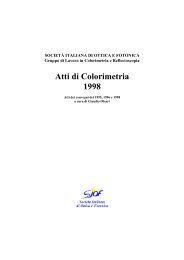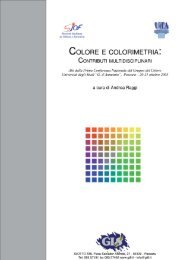Scarica gli atti - Gruppo del Colore
Scarica gli atti - Gruppo del Colore
Scarica gli atti - Gruppo del Colore
You also want an ePaper? Increase the reach of your titles
YUMPU automatically turns print PDFs into web optimized ePapers that Google loves.
interval (in which case, the system sensitivity S varies for each sensor), or the light<br />
sources employed show a very narrow emission spectrum. In both cases, the value<br />
a obtained from an acquisition can be interpreted as the value of function<br />
E(λ)R(λ)S(λ) at a specific wavelength, so that, by changing sensors or light<br />
sources, different values of this function can be estimated on the whole visible<br />
light spectrum. For a given wavelength λi, Equation 1 then becomes<br />
(2) ai = E(λi)R(λi)S(λi) ,<br />
and if the properties of the illuminant and sensor(s) are known or can be measured,<br />
then the values E(λi) and S(λi) are known and R(λi) can be computed. As an<br />
alternative, the output values ai can be compared with the corresponding values<br />
previously obtained from the acquisition of a reference physical sample whose<br />
reflectance is known. If the result of this previous acquisition is indicated with ai´,<br />
then it is<br />
(3)<br />
27<br />
ai<br />
E<br />
=<br />
a′<br />
E<br />
i<br />
( λi<br />
) R(<br />
λi<br />
) S(<br />
λi<br />
)<br />
( λ ) R′<br />
( λ ) S(<br />
λ )<br />
i<br />
i<br />
i<br />
R<br />
=<br />
R<br />
( λi<br />
)<br />
′ ( λ )<br />
i<br />
,<br />
where R´ is the (known) reflectance of the reference sample. The value of R(λi)<br />
can then be computed using the following equation:<br />
i<br />
(4) R( λ ) R′<br />
( λ )<br />
i<br />
a<br />
= i .<br />
a′<br />
i<br />
If necessary, the mo<strong>del</strong> can be further complicated to cope with such phenomena<br />
as internal light scattering and re-emission. Also, appropriate steps can be taken to<br />
account for any fluorescence, if needed.<br />
Multispectral acquisition systems that use this approach can be extremely precise;<br />
however, they also often suffer from drawbacks including expensiveness, need of<br />
specialized personnel for the operation, bulky and unwieldy machinery, and<br />
misalignment problems.<br />
3. ‘Wide-band’ multispectral imaging<br />
The second approach to multispectral acquisition is based on wide-band sensors. In<br />
this case, each sensor is sensitive to light energy in a sufficiently large wavelength<br />
interval, and the emission of the light source considered has a sufficiently broad<br />
spectrum, so that the values ai obtained from the acquisition cannot be associated<br />
to specific wavelengths. The relationship between these values and the actual<br />
reflectance values must then be somehow established to estimate the reflectance





